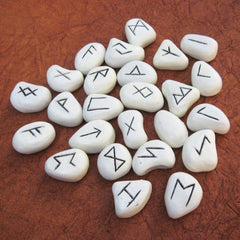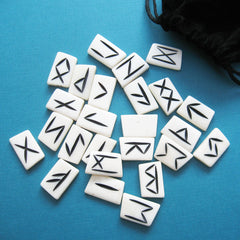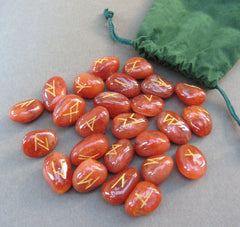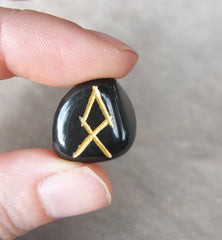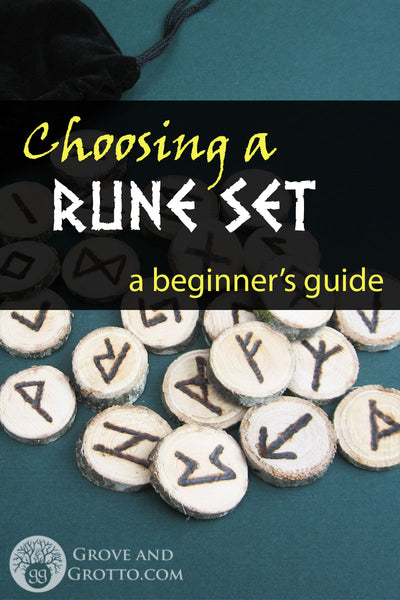
Thinking about taking up the runes? Mastery of the runes can take many years, but it is not difficult for a beginner to learn the basics. (Much as young children can quickly learn their ABCs.) The first learning tool you’ll need is a rune set of your own, to begin familiarizing yourself with this ancient system of knowledge.
First, some background: Runes are archaic European letters used in magick and divination. The best-known runic alphabet is the Elder Futhark, which contains 24 symbols.There are other rune systems, such as the Younger Futhark, Northumbrian runes, and Witches' runes. But most of the time, when people talk about reading runes, they are referring to the Elder Futhark, which fell out of use as an alphabet around the 8th century AD.
Each rune has a threefold meaning: A phonetic sound (as a letter of the alphabet), a mundane object or action that it stands for, and a mystical or abstract significance. Rune-casting—or reading the runes—is a way to activate intuition and gather information about the past, present and future. Runic symbols have powerfully condensed meaning. Sometimes, a single letter says something that paragraphs cannot.
Make or buy?
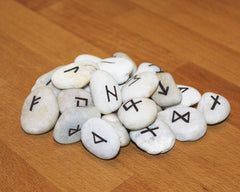
Making your own set of rune stones or tiles is an excellent way to begin to learn the runic symbols. Painting or carving the runes can be a kind of meditation, and help to infuse your new rune set with your energy. Depending on your level of craftiness and the tools/materials available to you, making your first rune set can be a great option that lets you express your creativity.
On the other hand, there are many beautiful rune sets for sale—many made with materials and techniques that would not be practical to replicate at home. Investing in a pre-made rune set that calls to you can be an equally good beginning to your runic studies.
Usually, rune sets for sale at metaphysical stores include the 24 Elder Futhark runes. Most also have one blank (or “wyrd”) rune that acts as a wild card. A drawstring bag or box and a set of basic instructions may also come with your runes. However, don’t feel that you have to use any of these items just because they were sold as a set. Rune-reading practices vary greatly, and eventually you will settle on a method that works for you.
Making your own runes
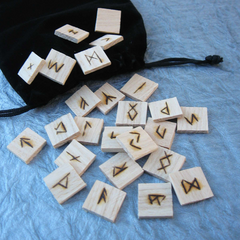
If you go the route of making your own Elder Futhark runes, you will need 24 roughly equal-sized objects that will become your rune tiles. (25 if you wish to include a blank rune.) Your backyard or local craft store probably has something that can be made into runes. (Be sure to practice good magickal etiquette if you take something from nature.) Wooden nickels, tree branch slices, earthen clay, and even glass aquarium gems all make serviceable homemade runes.
Obviously, some materials are more durable than others. I made my first set of runes with flat rocks gathered from a streambed. I didn’t realize that they were made out of fragile sedimentary rock. They flaked and crumbled to pieces after several weeks of being dry. Uncured wood will split, and painted symbols will chip off when the runes tumble together in a bag. It may take some trial and error to make a rune set that can endure being carried around and used in readings. Wood-burning, clear-coating, kiln-firing and engraving are all crafting techniques that will help your handmade runes stand up to wear and tear.
Materials
Rune sets can be made from a staggering variety of materials: Glass, bone, antler, wood, gemstone, ceramic, metals, and common stones. What you choose mainly depends on your preferences and budget. What feels most magickal to you?
Bone runes are made from cleaned animal bones, which are then painted or engraved with the runic symbols. (I’ll admit that bone items personally skeeve me out, but many Witches who work closely with the animal kingdom love them.) If you collect bones, or know someone who does, you can create your own set from the bones of a special animal. Commercial bone runes are usually made from water buffalo bone—a byproduct of meat and dairy farming in Asia.
Antler runes are made from cross-sections of deer antlers. Antlers are fast-growing bones, and their magickal properties are similar to bone. Antler runes would be a marvelous choice for a rune-reader who connects with Stag energy. (Both bone and antler runes look like puppy treats to dogs—so keep your prized rune set away from Fido.)
Wood runes can be made from nearly any type of wood. You may wish to choose one of the folkloric magickal woods for your rune set (Oak, Ash, Elder), or some other wood with a personal significance. Wood runes may be painted, engraved, woodburned—or a combination of these methods. A sealant or varnish gives the wood a lovely sheen and helps protect the symbols, but many rune-readers prefer to keep it all natural with a light coating of oil or beeswax.
Stone runes are made with precious gems, semi-precious stones, or even ordinary pebbles. Some Norse Pagans I know insist that wood and bone are the only proper materials for rune tiles. Rune stones, they say, are a modern, New Age invention.
Even so, gemstone rune sets—which combine the metaphysical lore of crystals with the runic alphabet—are probably the most popular type of rune set among Wiccans and Pagans. Gemstone runes are pleasingly heavy when cast, and undeniably beautiful to work with. You can choose your gemstone rune set based on the magickal properties of the stone—Amethyst for intuition, Jasper for courage, Hematite for protection, etc.

Ceramic runes include rune tiles made from air-dried, oven-baked, or kiln-fired clay. (The latter is the most durable.) They are popular with DIY-ers, and those who connect especially with the element of Earth. One of my favorite artisans makes rune sets from fragments of pottery that have washed ashore in her coastal town—they are unique and colorful runes of Earth and sea!

Glass runes and pewter runes are specialty items that are hard to find. Though these materials are made by humans, they are perfectly appropriate for magickal work if they appeal to you.
Are there any materials that should not be made into runes? I’m a magickal pragmatist. I’m into what works, and I don’t have much regard for sacred cows. But. As a magickal pragmatist, it’s perfectly fair to point out that the runes work best when treated with the utmost respect and dignity. Odin, it is told, hung on the World Tree for nine days and nine nights in order to receive the secret of the runes. It just seems wrong to look up the symbols on Pinterest and start carving them onto Styrofoam.
You can argue, I suppose, that since the runes are a sacred alphabet, they sanctify everything they touch. And yet, I have an instinctive revulsion toward runes made from paper, wood composites, and plastics (polymer clay included).
The runic symbols are worthy of great reverence—but there are no absolutes when it comes to selecting rune tiles. I recently broke my own rules and added a set of inexpensive resin runes to my store. I wouldn’t want a lack of money to prevent anyone from studying the runes. Even a basic set of runes can become a powerful tool in the hands of a serious seeker.
Size and Shape
All settled about the material? It’s time to spare a bit of thought on the size of your runes. Runes, especially gemstone runes, may be as small as a half-inch—too small to be practical for most readers. Basically, you want the rune set to be easy to read, and to feel comfortable in your hands. If you’re going to be reading for others, or in low light, go a bit larger. Even big runes are really travel-sized!
Rune tiles vary in size and shape, even within the same set. If you use the “blind draw” method of rune-reading (putting your hand in the bag and feeling around), it becomes more important for the runes to be a fairly uniform size.
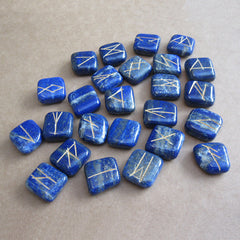
One final consideration is the shape of the runes: Flat, round, symmetrical? Round-ish runes are fine for drawing from the bag. But if you want to lay your runes out in lines or grids, tile-shaped is the way to go.
Some rune readers—but not all—read “reversed” runes. Reversals give a different meaning when a rune lands face-down, or upside-down. If your rune tiles are very round and/or symmetrical, it will be more difficult to tell when a rune comes up reversed. Some runes (like Isa and Gebo) look the same whether they're upright or inverted. If getting the reversed meaning is important to you, get an asymmetrical set and memorize the orientation.
Choosing your first rune set can be intimidating, but it doesn't have to be. Pick a set you're drawn to, learn the symbols, and begin using the power of the runes to transform your life and magick!
Read more articles in the archive, or shop for runes.


